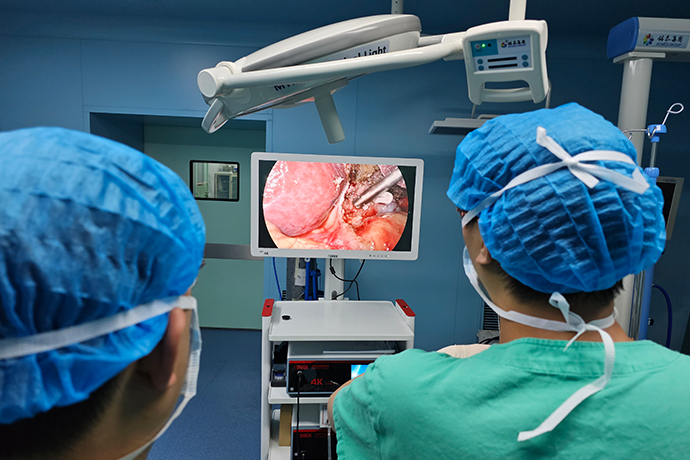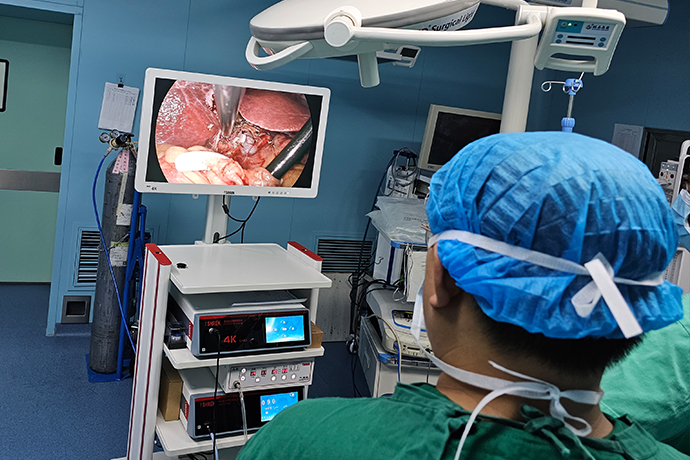[Thoracoscopic Thoracic Surgery] Diverticulectomy under 4K ultra-high definition thoracoscopic surgery
Release time: 21 Feb 2024 Author:Shrek
Esophageal diverticulum (diverticulum of oesophagus) refers to the sac-like protrusion that communicates with the esophagus. Its classification is relatively complicated.
According to the location of the disease, it can be divided into: pharyngeal esophageal diverticulum, mid-esophageal diverticulum and supradiaphragmatic esophageal diverticulum.
According to their different pathogenesis, they are divided into: traction, internal pressure, and traction and internal pressure diverticula.
According to the composition of the diverticular wall, it can be divided into: true diverticula (containing the full thickness of the esophageal wall) and pseudodiverticula (lack of the muscular layer of the esophageal wall).
In addition, it can be divided into: congenital diverticula and acquired diverticula.

The etiology and pathogenesis of esophageal diverticula are not fully understood.
Pharyngeoesophageal diverticulum is a bulge of the mucosa and submucosa of the pharyngoesophageal junction area at the muscle defect of the posterior pharyngeal wall proximal to the cricoid cartilage. It is also called Zenker’s diverticulum or pharyngeal pouch.
The upper esophageal sphincter (UES) is composed of the cricopharyngeal muscle, hypopharyngeal constrictor muscle and annular fibers at the upper end of the esophagus. Its main functions are:
(1) Keep the esophagus closed at rest to prevent esophageal contents from refluxing into the pharynx and protect the trachea and bronchi from invasion by esophageal contents.
(2) Block air from being inhaled into the esophageal cavity and prevent esophageal dilation caused by breathing.
(3) Open immediately when swallowing to ensure that an appropriate amount of food bolus quickly passes through the pharynx and enters the esophagus.
(4) There is a triangular weak area lacking muscle layer on the posterior wall of the UES, that is, between the oblique fibers of the hypopharyngeal constrictor muscle and the transverse fibers of the cricopharyngeal muscle. During swallowing, the LES fails to fully relax in a coordinated manner, resulting in this weakness. The pressure within the area increases sharply, causing the local mucosa to herniate from the weak area, forming an intra-pressure pseudodiverticulum.
Mid-esophageal diverticula often occur on the anterior and anterolateral walls of the esophagus at the tracheal bifurcation.
Its formation is related to inflammation and scar shrinkage of adjacent trachea and bronchial lymph nodes (especially tuberculous inflammation), which causes the esophageal wall to be pulled outward to form a traction diverticulum.
The exact cause of supradiaphragmatic esophageal diverticulum is unknown, but it often coexists with achalasia, diffuse esophageal spasm, diaphragmatic hernia, and Barret's esophagus. It may be related to congenital dysplasia or esophageal motility dysfunction.
Key points of surgical operation: Regardless of open surgery or laparoscopic surgery, after entering the chest, first incise the mediastinal pleura above and below the lesion, free the esophagus, and expose the diverticulum. If the diverticulum opens distally, the bottom of the diverticulum can be pulled proximally to completely expose the relationship between the diverticulum and the esophagus. The diverticulum is resected from the base, the esophageal incision is sutured, and the mediastinal pleura is embedded. For traction diverticulum, the mediastinal pleura is incised and the adhesions around the esophageal diverticulum are freed. If the diverticulum is small, the diverticulum can be retracted after the adhesions are released, and then the esophageal muscle layer can be embedded with a few needles. If the diverticulum is large, the excess wall can also be removed.
In recent years, the use of cutting staplers has greatly simplified surgical operations. However, it should be noted that sufficient esophageal wall should be left to ensure that the esophageal cavity will not be narrowed after suturing.
For pouch-type diverticulum, the diverticulum pouch can be removed using a cutting suture device after the pouch is fully freed and the esophagus is exposed.
How to prevent esophageal diverticula?
There is currently no specific prevention method for esophageal diverticula, but developing good living habits can prevent the disease.
1. Reasonable diet: Pay attention to maintaining a balanced diet in your daily diet, and avoid overeating spicy and greasy foods, such as chili peppers, fried foods, etc. At the same time, avoid overeating and eat regularly and quantitatively.
2. Scientific exercise: Carry out regular exercise to increase the body’s resistance. But we should pay attention to gradual and long-term persistence.
3. Early intervention for high-risk groups: Patients suffering from esophageal spasm, gastroesophageal reflux, esophageal candidiasis and other diseases should undergo regular barium meal X-ray examinations to achieve early detection and treatment and reduce the risk of disease.

- Recommended news
- 【General Surgery Laparoscopy】Cholecystectomy
- Surgery Steps of Hysteroscopy for Intrauterine Adhesion
- [Gynecological Hysteroscopy] Techniques for Preventing and Treating Complications of Hysteroscopic Surgery
- [Gynecological Hysteroscopy] Hysteroscopic Adhesiolysis
- [Gynecological Hysteroscopy] IUD Removal under Hysteroscopy